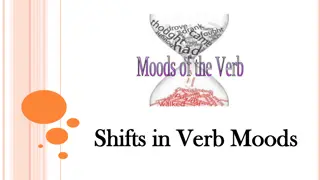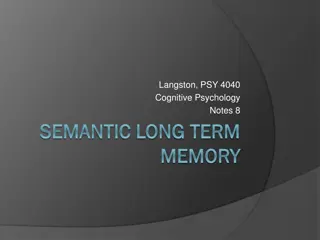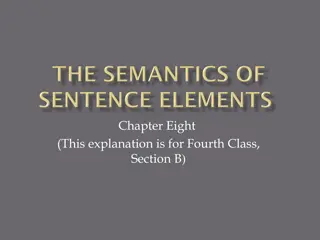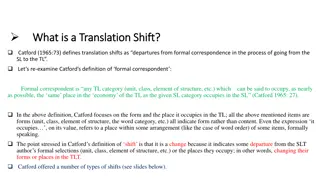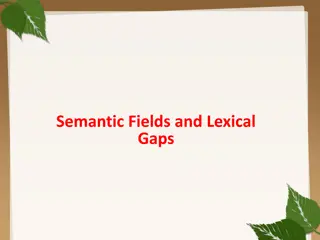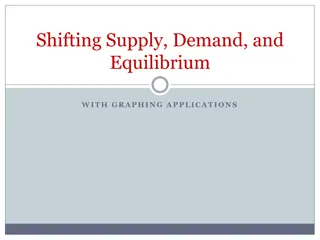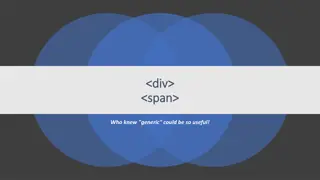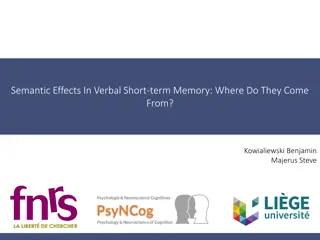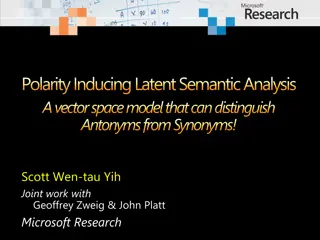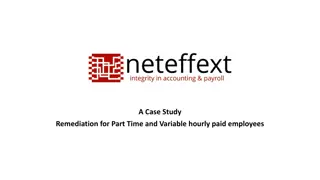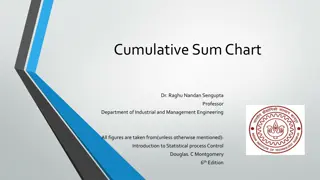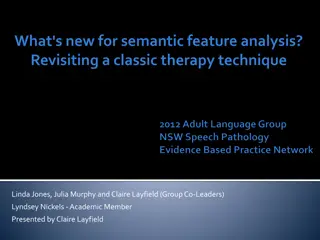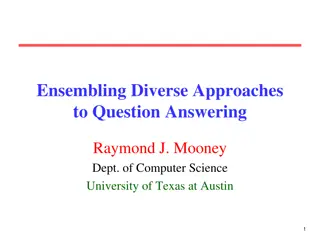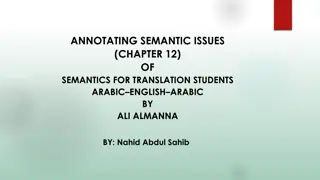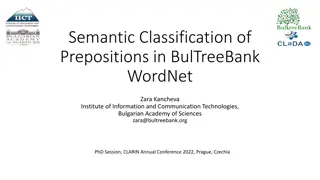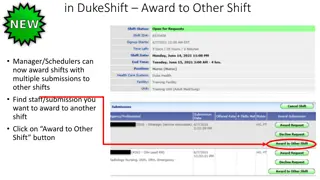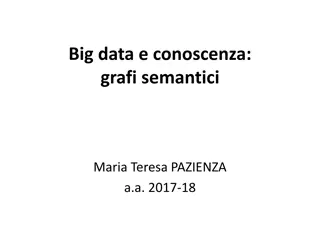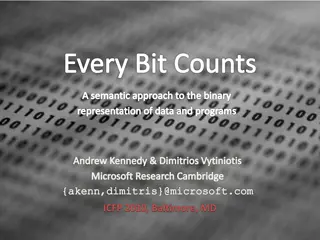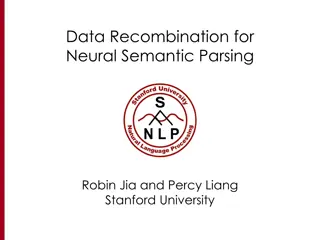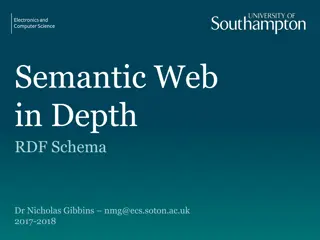The Semantic Argument for the Existence of God - International Conference Insights
Explore the Semantic Argument and its implications for the existence of God as presented by Emanuel Rutten at the International Proofs of God's Existence Conference. The lecture delves into universal properties, formal versus non-formal properties, and the likelihood of God's existence based on thes
0 views • 14 slides
Understanding Semasiology: The Study of Word Meaning
Semasiology is a branch of linguistics focused on the meaning of words. It delves into various aspects of lexical meaning, semantic development, polysemy, and semantic structure. Through exploring types of word meanings and semantic changes, semasiology helps us comprehend the intricate nuances of l
4 views • 19 slides
Correcting Inappropriate Shifts in Verb Moods
Inappropriate shifts in verb moods can confuse readers and obscure the meaning of sentences. This article provides examples of incorrect shifts and their corrections, emphasizing the importance of maintaining consistency in verb moods within a sentence.
0 views • 13 slides
Understanding Semantic Memory Models in Cognitive Psychology
Explore the structure and processes of semantic memory through traditional and neural network views. Delve into symbolic and network models, such as Collins & Quillian's 1970 model, which organize concepts as nodes and links, depicting relationships between concepts within semantic memory representa
1 views • 78 slides
Understanding Semantic Roles in Linguistics
Semantic roles, also known as theta roles, play a crucial part in understanding the relationships between participants and verbs in a sentence. They include agents, experiencers, causers, positioners, subject complements, and objects. Agents are typically the doers of actions, experiencers receive e
1 views • 18 slides
Understanding Semantic Roles in Sentence Structure
Semanticists analyze sentences based on semantic structure rather than traditional syntactic terms like subject and object. Instead, they use semantic terms such as Agent, External causer, Instrument, Affected, Recipient, and Locative. These terms help describe how people and things participate in r
1 views • 26 slides
Understanding Translation Shifts According to Catford (1965)
Definition and explanation of translation shifts according to Catford (1965), focusing on formal correspondence, levels of shifts, structure shifts, category shifts, class shifts, unit shifts, and intra-system shifts in the process of translating from the source language (SL) to the target language
2 views • 4 slides
Understanding NMR Spectroscopy and Chemical Shifts
Nuclear Magnetic Resonance (NMR) spectroscopy is a powerful technique for analyzing molecular structures based on the chemical shifts of protons. In an NMR spectrum, peaks correspond to different protons in a compound, with their positions, intensities, and spin-spin splitting providing valuable inf
0 views • 19 slides
Semantic Analysis of Clinical Narratives Using Complex Knowledge Graphs
Need for improved semantic analysis of clinical narratives for information retrieval and decision support is addressed through the use of complex knowledge graphs. These graphs capture axiomatic descriptions of generalizable truths about entities in the medical domain, providing a language-independe
0 views • 8 slides
Benefits of Vocantas Mobile App and Online Portal
Explore the benefits of using the Vocantas Mobile App and Online Portal, including easy installation on mobile devices, managing notifications, shift filtering, bidding on future shifts, receiving notifications on shift awards, adding shifts to your calendar, and more. The Online Portal offers featu
0 views • 9 slides
Understanding Semantic Properties in Lexical Semantics
Explore the concept of semantic properties in lexical semantics through examples involving word meanings and relationships. Learn how semantic properties form the basic building blocks of language construction, sharing common attributes among words while also showing contrastive distinctions. Dive i
0 views • 17 slides
Evolution of Semantic Field Theory in Linguistics
The theory of semantic fields, also known as field-theory, originated in the 1920s and 1930s with German and Swiss scholars. J. Trier and L. Weisgerber further developed this theory post World War II, associating it with the Language and Society movement. Trier's approach focused on comparing the st
0 views • 20 slides
Manage Your Work Schedule Efficiently with Schedule Source Calendar Swap Board
Access your work schedules through Schedule Source to easily find substitutes for work shifts posted on the swap board. Simply log in to your personal portal, view your schedule on My Calendar, and learn how to put shifts on the swap board or pick up available shifts. Stay organized and stay in cont
0 views • 14 slides
Understanding Shifts in Supply, Demand, and Equilibrium through Graphing Applications
Explore various scenarios affecting the demand for beef, such as changes in consumer expectations, arrival of immigrants, shifts in prices of substitute goods, and warnings on health implications. Understand how these factors lead to shifts in demand curves and impact market equilibrium.
14 views • 26 slides
Understanding the Importance of Semantic HTML Tags
In this lecture, we delve into the significance of semantic HTML tags in structuring web content. We explore when to use
2 views • 9 slides
Exploring Semantic Web Technologies: RDFa, GRDDL, and POWDER
Delve into the depths of Semantic Web technologies with a focus on RDFa, GRDDL, and POWDER through the guidance of Dr. Nicholas Gibbins. Learn about embedding Semantic Web data, republishing embedded data, and the usage of GRDDL for XML transformations.
13 views • 38 slides
Understanding Semantic Properties of Verbs in English Language
Explore the semantic properties of English verbs through various examples and classifications. Discover how verbs like hit, kiss, and touch share common properties, while verbs like make, create, imagine, and build belong to different classes based on their semantic relationships. Delve into the gra
0 views • 17 slides
Semantic Web Technologies and Knowledge Representation Overview
Semantic Web technologies such as RDF, RDFS, OWL, and SPARQL form the basis of a web of data designed for machine understanding. Knowledge representation languages play a crucial role in AI, with Semantic Web languages like OWL leading the current generation. Contrasting database and knowledge base
0 views • 50 slides
Dynamic Semantic Parser Approach for Sequential Question Answering
Using a Dynamic Semantic Parser approach, the research focuses on Sequential Question Answering (SQA) by structuring queries based on semantic parses of tables as single-table databases. The goal is to generate structured queries for questions by defining formal query languages and actions for trans
0 views • 23 slides
Understanding Semantic Effects in Verbal Short-term Memory
Investigating the impact of semantic knowledge and similarity on verbal short-term memory, this study delves into how imageability of words influences recall. Key findings highlight the influence of semantic relatedness and the imageability effect on memory retention, shedding light on the mechanism
0 views • 47 slides
Unveiling Polarity with Polarity-Inducing Latent Semantic Analysis
Polarity-Inducing Latent Semantic Analysis (PILSA) introduces a novel vector space model that distinguishes antonyms from synonyms. By encoding polarity information, synonyms cluster closely while antonyms are positioned at opposite ends of a unit sphere. Existing models struggle with finer distinct
1 views • 29 slides
Multimodal Semantic Indexing for Image Retrieval at IIIT Hyderabad
This research delves into multimodal semantic indexing methods for image retrieval, focusing on extending Latent Semantic Indexing (LSI) and probabilistic LSI to a multi-modal setting. Contributions include the refinement of graph models and partitioning algorithms to enhance image retrieval from tr
1 views • 28 slides
Understanding Equilibrium Shifts and Market Reactions in Economics
Explore the impact of events on supply and demand, equilibrium shifts, new price and quantity levels, market corrections for disequilibrium, shortages, and surpluses. Learn how markets adjust to maintain balance and prices fluctuate based on changes in supply and demand. Discover the dynamics of mar
0 views • 5 slides
Semantic Data Model of Electronic Invoicing Core Elements
Presentation by Fred van Blommestein on the EN16931-1 semantic data model of core elements in electronic invoicing, covering invoice processes, core invoice design, semantic model details, business rules, and invoicing principles. The model includes 160 elements in 33 groups, with mandatory elements
0 views • 13 slides
Remediation Strategies for Part-Time and Variable Hourly Employees in Holiday Act Compliance
This case study delves into the challenges faced in managing leave liabilities for part-time and variable hourly employees under the Holidays Act 2003. It explores various working profiles such as split shifts, cycle shifts, variable shifts, and seasonal work, presenting issues in calculating leave
0 views • 18 slides
Understanding the Limitations of Shewhart Control Charts in Process Monitoring
Shewhart control charts, while effective for detecting larger process shifts, have limitations in detecting smaller shifts due to relying on individual sample observations. This can be a drawback in phase II process monitoring scenarios where smaller shifts are of interest. Alternatives like the cum
0 views • 25 slides
Revisiting Semantic Feature Analysis: A Classic Therapy Technique
Aphasia often involves semantic breakdown, and Semantic Feature Analysis (SFA) is a foundational technique for various treatments addressing semantic impairments. This presentation explores the effectiveness of SFA in improving naming, generalization to spontaneous speech, and treatment goals beyond
0 views • 16 slides
Understanding Shifts in Supply and Demand
Explore how changes in non-price factors can lead to shifts in supply and demand curves. Examples illustrate the impact of events like droughts and consumer preferences on equilibrium price and quantity in markets such as salmon. Graphical analyses demonstrate the effects of shifts on price and quan
0 views • 10 slides
Integrated Reporting Workshop Wrap-Up and Next Steps
The workshop on integrated reporting held on 1st December 2022 focused on enhancing proposals, planning JBRC setup, data dictionary governance, semantic integration, and more. The roadmap for 2023 includes topics like data granularity, governance, and continuous work on semantic and syntactic layers
0 views • 4 slides
Semantic Relations Expressed by Prepositions in Modeling Study
Explore the study on modeling semantic relations expressed by prepositions conducted by Vivek Srikumar and Dan Roth from the University of Illinois, Urbana-Champaign. The research delves into prepositions triggering relations, ontology of preposition relations, examples of preposition relations, pre
0 views • 25 slides
Ensembling Diverse Approaches to Question Answering
Diverse types of question answering approaches include factoid querying, compositional querying of structured databases/knowledge graphs, reading comprehension, and visual question answering. Limitations of factoid question answering are also discussed, highlighting the need for specific queries and
0 views • 28 slides
Annotating Semantic Issues in Translation for Students
This chapter delves into semantic issues in translation, aiming to assist students in annotating their translations from a semantic viewpoint. It emphasizes using semantic information to aid in translating data accurately while maintaining communicative effectiveness. The story discussed highlights
0 views • 19 slides
Semantic Classification of Prepositions in Bulgarian WordNet: A Comprehensive Overview
This presentation delves into the semantic classification of prepositions in the BulTreeBank WordNet, focusing on the incorporation of prepositions, closed-class words, and the benefits for neural model building in Bulgarian language processing. The motivation behind the study, challenges posed by p
0 views • 7 slides
Efficient Shift Award Management in DukeShift System
DukeShift system allows Shift Managers/Schedulers to award shifts to staff members across different shifts. The process involves selecting staff submissions, choosing alternative shifts, ensuring correct dates, adding notes, and completing the award. For any questions, contact APIResourceGroup@duke.
0 views • 11 slides
Mid-Tudor Crisis: A Comprehensive Overview
The period from 1540 to 1569 marked a tumultuous time in Tudor history, characterized by political instability, economic challenges, religious turmoil, and societal shifts. Key questions surrounding the crisis include the extent of royal authority restoration, governance effectiveness, foreign relat
0 views • 28 slides
Semantic Technologies for Data Management and Knowledge Extraction
An exploration of how semantic technologies facilitate data management, knowledge extraction, and understanding in the realm of big data. Topics covered include semantic graphs, content information extraction, and the impact of semantic models on enhancing data value and relationships. The importanc
0 views • 38 slides
Requirements for Semantic Biobanks and Global Biobank Data Retrieval
Explore the critical aspects of semantic interoperability in biobanking, highlighting the need for formal ontologies, comprehensive annotations, and model of meaning data. The (Generalized) Biomedical Retrieval Scenario underscores the importance of effective resource retrieval based on content-base
0 views • 16 slides
Exploring Binary Representation and Semantic Approaches in Data and Programs
Delve into the fascinating realm of binary representation and semantic approaches in data and programs through a series of discussions and examples. Topics include encoding/decoding relevance, tamper-proof bytecode formats, incorporating semantic info for compact encodings, and playing guess-who gam
0 views • 21 slides
Advances in Neural Semantic Parsing
Delve into the realm of neural semantic parsing with a focus on data recombination techniques, traditional parsers, and the shift towards domain-general models. Explore the application of sequence-to-sequence models and attention-based neural frameworks in semantic parsing tasks. Discover the evolvi
0 views • 67 slides
Understanding RDF Schema: A Deep Dive into Semantic Web
In this detailed exploration of RDF Schema, Dr. Nicholas Gibbins covers topics such as defining classes and properties, subclass relationships, semantic implications, reflexive properties, type distribution, and property definitions in RDF. Learn about the essential aspects of RDF Schema and its rol
0 views • 19 slides


